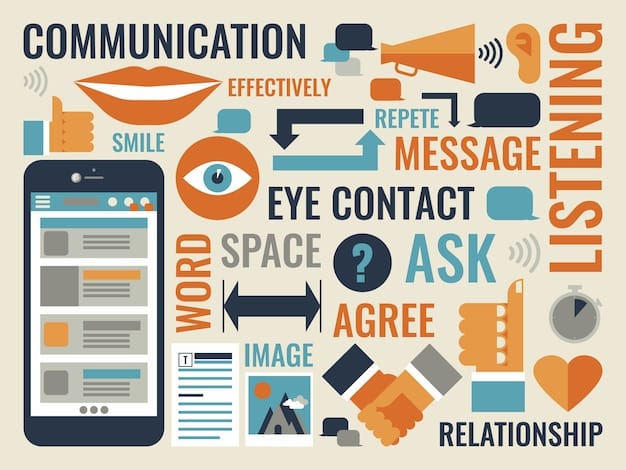Communication Research 2025: 3 New Findings & How to Adapt

Latest research on communication highlights the growing importance of personalized messaging, the ethical considerations of AI in interactions, and the need for enhanced empathy in a digitally driven world, reshaping how individuals and organizations will connect in 2025.
The way we communicate is constantly evolving, and 2025 promises to bring some significant shifts. Latest research on communication: 3 new findings that will change how you interact in 2025 are emerging that will require us to adapt our strategies and approaches to connect effectively in both personal and professional contexts.
The Rise of Personalized Communication
Personalized communication is more than just using someone’s name in an email. It’s about understanding individual preferences, needs, and communication styles to create tailored messages that resonate deeply. As we move towards 2025, this trend is set to become even more critical for effective interaction.
Understanding Individual Communication Styles
People have different preferences when it comes to how they receive and process information. Some prefer visual aids, while others respond better to auditory cues. Recognizing these differences will be essential in crafting personalized messages that truly connect.
Leveraging Data for Tailored Messaging
Data analytics provides valuable insights into audience behavior and preferences. By leveraging this data, communicators can create highly targeted messages that address specific needs and interests, increasing engagement and impact.

Here are key strategies for implementing personalized communication:
- Audience Segmentation: Divide your audience into smaller groups based on demographics, interests, and behavior.
- Customized Content: Create messages that speak directly to the needs and preferences of each audience segment.
- Feedback Loops: Encourage feedback to continuously refine your understanding of audience preferences.
- Technology Integration: Utilize tools and platforms that enable personalized messaging and data analysis.
By embracing personalized communication, individuals and organizations can build stronger relationships, increase engagement, and achieve better outcomes in their interactions. It’s about making every message count by ensuring it resonates with the individual receiving it.
Ethical Implications of AI in Communication
Artificial intelligence (AI) is transforming communication, offering new possibilities for automation, personalization, and efficiency. However, the integration of AI also brings significant ethical considerations that must be addressed to maintain trust and integrity in interactions. In 2025, these ethical questions will be even more pressing.
Transparency and Disclosure
One of the primary ethical concerns is the need for transparency when using AI in communication. Individuals should be aware when they are interacting with an AI system rather than a human, ensuring they can make informed decisions about how they engage.
Bias and Fairness
AI algorithms can perpetuate and amplify existing biases if they are trained on biased data. Ensuring fairness and equity in AI communication systems is crucial to prevent discrimination and promote inclusivity.
Ethical guidelines for AI in communication include:
- Accountability: Establish clear lines of responsibility for AI-driven communication systems.
- Privacy Protection: Implement robust measures to protect user data and privacy.
- Human Oversight: Maintain human oversight of AI systems to prevent errors and ensure ethical considerations are addressed.
- Regular Audits: Conduct regular audits of AI algorithms to identify and mitigate biases.
Addressing these ethical implications is essential for fostering trust and ensuring that AI is used responsibly in communication. By prioritizing transparency, fairness, and accountability, we can harness the power of AI while upholding ethical standards.
The Importance of Empathy in Digital Interactions
In an increasingly digital world, empathy is becoming a critical skill for effective communication. Digital interactions often lack the nonverbal cues and contextual understanding that enrich face-to-face communication, making it challenging to build rapport and connect on a human level. As we move toward 2025, the ability to empathize in digital contexts will be more important than ever.
Active Listening and Emotional Intelligence
Active listening involves paying close attention to what others are saying, both verbally and nonverbally, and demonstrating genuine interest. Emotional intelligence helps us understand and manage our own emotions and recognize the emotions of others, enabling us to respond with empathy and sensitivity.
Building Trust and Rapport Online
Building trust and rapport online requires conscious effort. It involves being authentic, transparent, and responsive, and showing genuine care for the needs and concerns of others.

Strategies for enhancing empathy in digital interactions:
- Use Empathetic Language: Choose words that convey understanding and support.
- Acknowledge Emotions: Recognize and validate the feelings of others.
- Offer Solutions: Provide helpful and practical solutions to address concerns.
- Personalize Responses: Tailor your responses to the individual and their specific situation.
By prioritizing empathy in digital interactions, we can foster stronger relationships, build trust, and create more positive and meaningful connections in the digital realm. It’s about recognizing that behind every screen is a real person with real emotions, and responding with compassion and understanding.
The Role of Visual Communication
Visual communication will continue to play a crucial role in how we interact in 2025. The human brain processes visual information much faster than text, making visuals a powerful tool for conveying complex ideas quickly and effectively. As attention spans continue to shrink, the ability to communicate visually will become even more important.
Infographics and Data Visualization
Infographics and data visualization tools can transform complex data into easily digestible visual formats. This makes it easier for audiences to understand key insights and trends, improving comprehension and retention.
Video Communication
Video communication will continue to dominate the digital landscape. Whether it’s live streaming, video conferencing, or short-form video content, video provides a dynamic and engaging way to connect with audiences and convey messages.
Best practices for effective visual communication:
- Keep it Simple: Avoid clutter and focus on conveying a clear and concise message.
- Use High-Quality Visuals: Ensure that images and videos are clear, sharp, and visually appealing.
- Tell a Story: Use visuals to create a narrative that engages and resonates with the audience.
- Optimize for Mobile: Ensure that visuals are optimized for viewing on mobile devices.
By mastering the art of visual communication, individuals and organizations can capture attention, convey ideas effectively, and create memorable experiences for their audiences. It’s about leveraging the power of visuals to enhance engagement and understanding in an increasingly visual world.
Adapting to Multimodal Communication
Multimodal communication, which involves combining various modes of communication such as text, audio, video, and visuals, is set to become the norm in 2025. This approach recognizes that people learn and process information in different ways, and by offering multiple modes of communication, we can cater to a wider range of preferences and needs.
Integrating Text, Audio, and Video
The integration of text, audio, and video provides a rich and engaging communication experience. For example, a presentation could combine text-based slides, audio narration, and video demonstrations to cater to different learning styles.
Utilizing Interactive Communication Platforms
Interactive communication platforms offer real-time engagement and feedback, enhancing the communication experience. These platforms often incorporate features such as polls, quizzes, and Q&A sessions to encourage active participation.
Strategies for embracing multimodal communication:
- Understand Your Audience: Know your audience’s preferences and needs to determine the most effective modes of communication.
- Plan and Integrate: Plan how you will integrate different modes of communication to create a cohesive and engaging experience.
- Test and Refine: Test different approaches and refine your strategy based on feedback and results.
- Invest in Technology: Invest in the tools and platforms that enable multimodal communication.
By embracing multimodal communication, individuals and organizations can create more engaging, effective, and inclusive communication experiences that resonate with diverse audiences.
Continuous Learning and Adaptation
The only constant in communication is change. As technology evolves and societal norms shift, we must commit to continuous learning and adaptation to stay ahead of the curve. In 2025, a growth mindset and a willingness to embrace new communication strategies will be essential for success.
Staying Updated with Industry Trends
Staying updated with industry trends involves regularly reading industry publications, attending conferences, and participating in online communities. This helps you stay informed about new technologies, strategies, and best practices.
Experimenting with New Communication Tools
Experimenting with new communication tools involves trying out new platforms, apps, and technologies to see how they can enhance your communication efforts. This could include exploring virtual reality, augmented reality, or new social media platforms.
Key steps for continuous learning and adaptation:
- Set Learning Goals: Define specific learning goals to focus your efforts and track your progress.
- Seek Feedback: Solicit feedback from peers, mentors, and audiences to identify areas for improvement.
- Reflect on Experiences: Take time to reflect on your communication experiences and identify lessons learned.
- Share Knowledge: Share your knowledge and insights with others to foster a culture of continuous learning.
By committing to continuous learning and adaptation, individuals and organizations can ensure that they remain effective communicators in the ever-changing landscape of 2025 and beyond.
| Key Point | Brief Description |
|---|---|
| 🎯 Personalized Communication | Tailoring messages to individual preferences increases engagement. |
| 🤖 Ethical AI Use | Transparency and fairness are crucial in AI-driven communication. |
| ❤️ Empathy Online | Building trust and rapport in digital interactions is key. |
| 👁️ Visual Communication | Using visuals helps convey complex ideas faster and more effectively. |
FAQ
▼
Start by understanding your audience’s preferences through surveys and feedback. Tailor your messages to address their specific needs and use their names to create a personal connection. Use data analytics for insights.
▼
Transparency is key; disclose when AI is being used. Ensure fairness by mitigating biases in algorithms. Protect user privacy and establish accountability for AI-driven communication systems. Maintain human oversight.
▼
Use empathetic language and acknowledge the emotions of others. Be responsive and offer practical solutions to their concerns. Show genuine care and personalize your responses to build trust and rapport online.
▼
▼
Conclusion
As we look to 2025, the latest research on communication underscores the importance of adapting to new technologies, ethical considerations, and the need for human connection. By embracing personalized messaging, addressing AI biases, and prioritizing empathy, we can create more meaningful and effective interactions in both our personal and professional lives.





